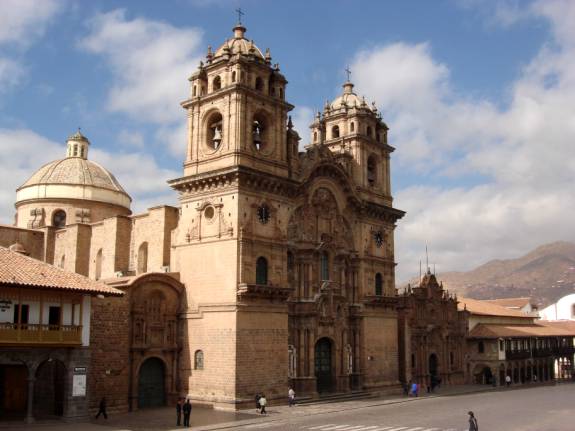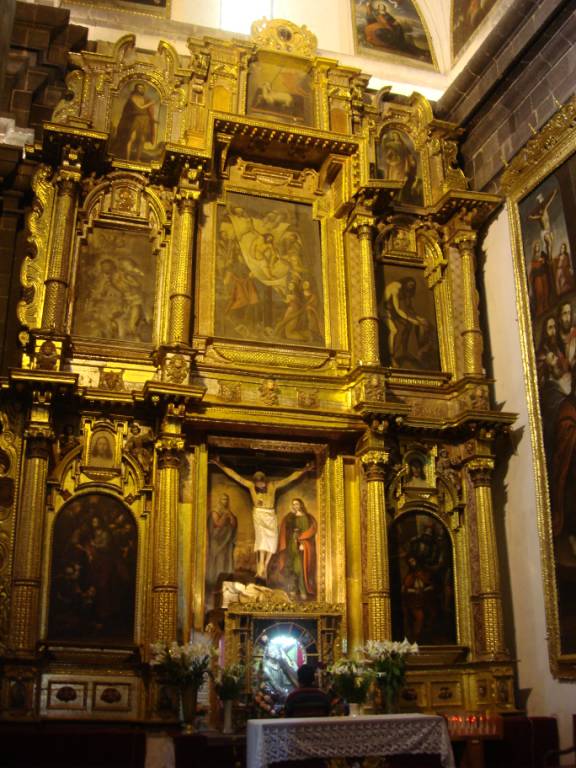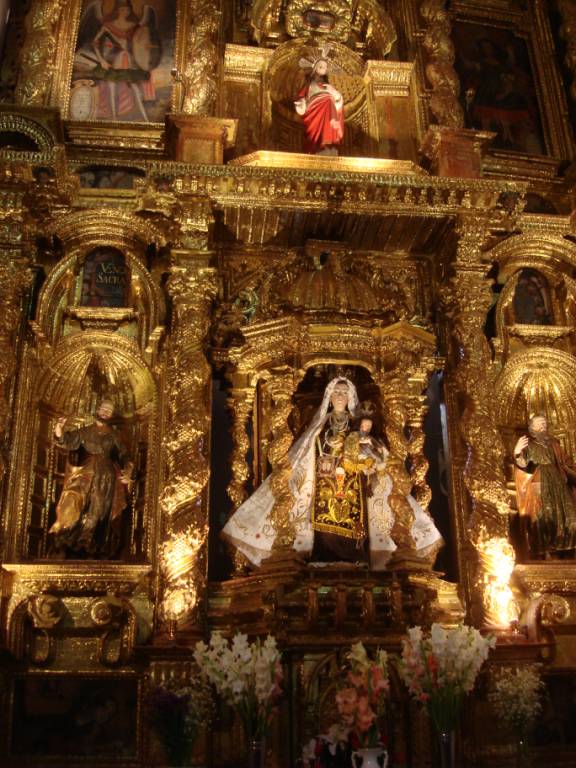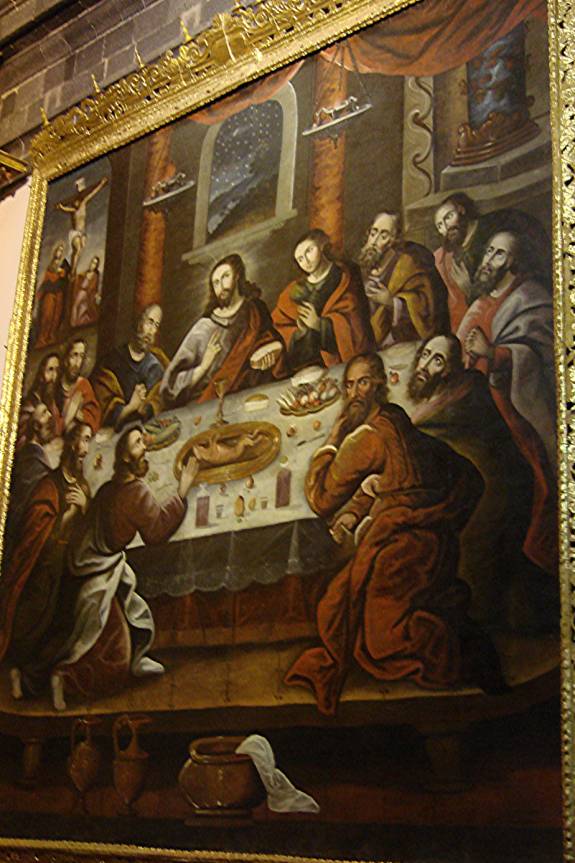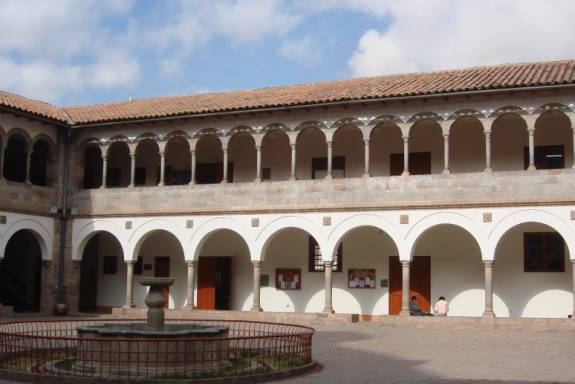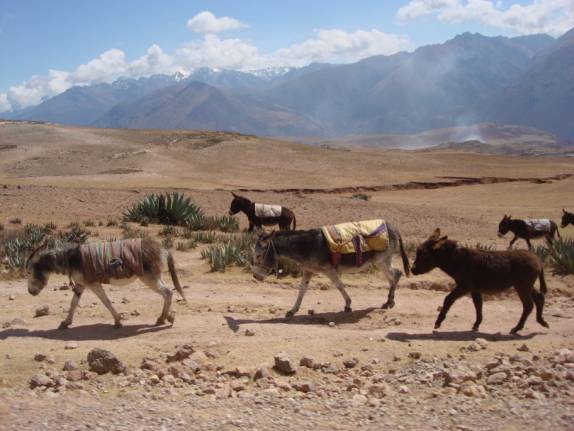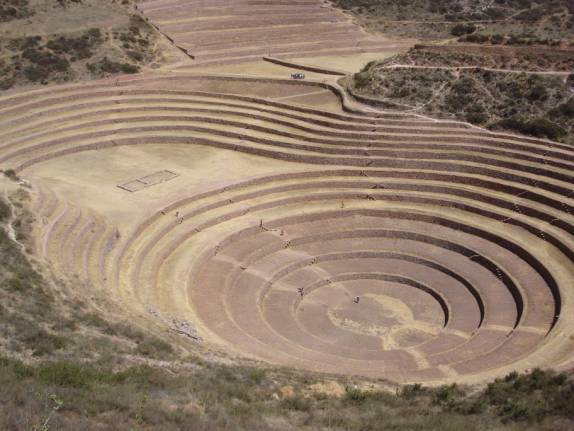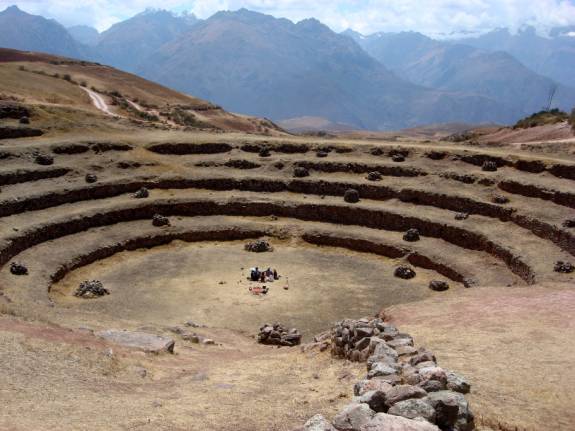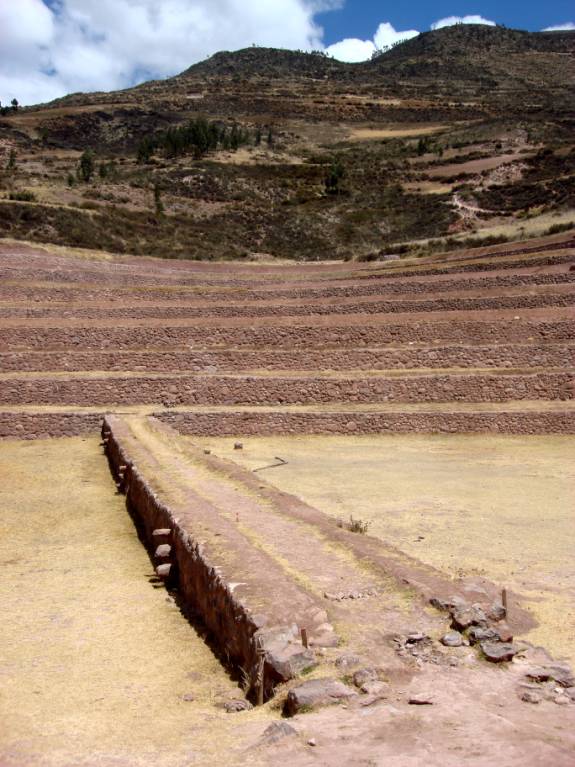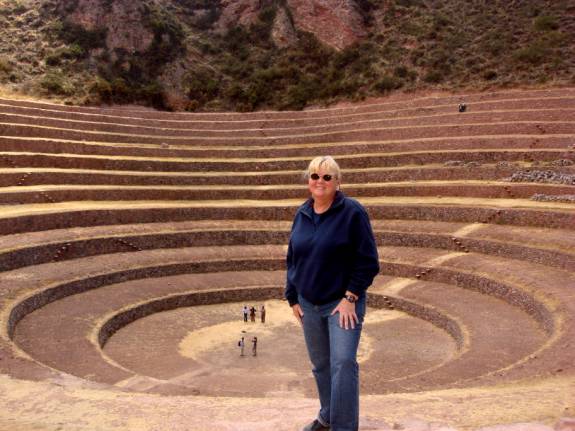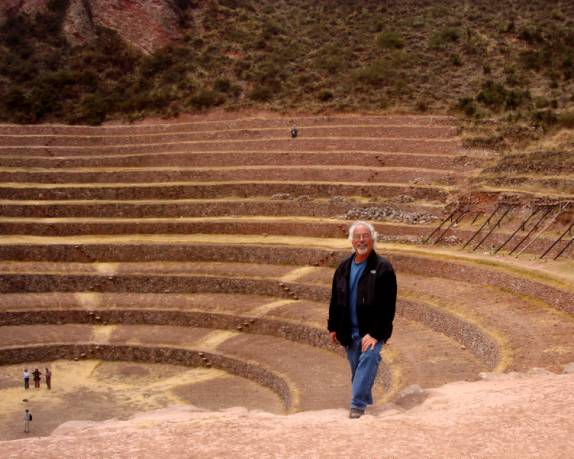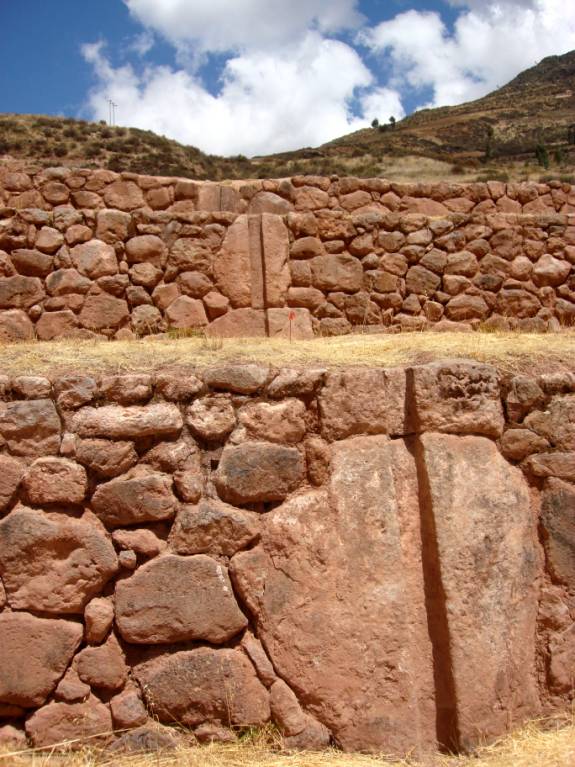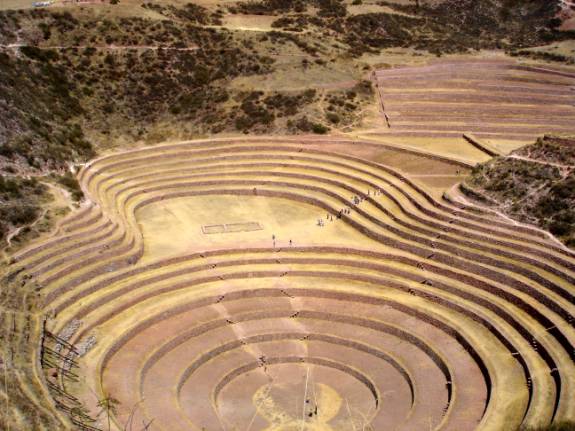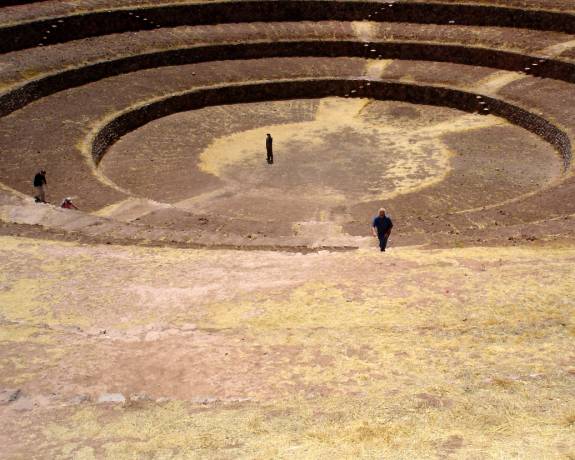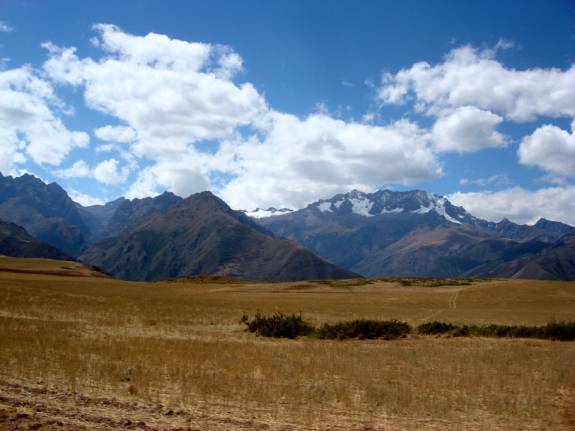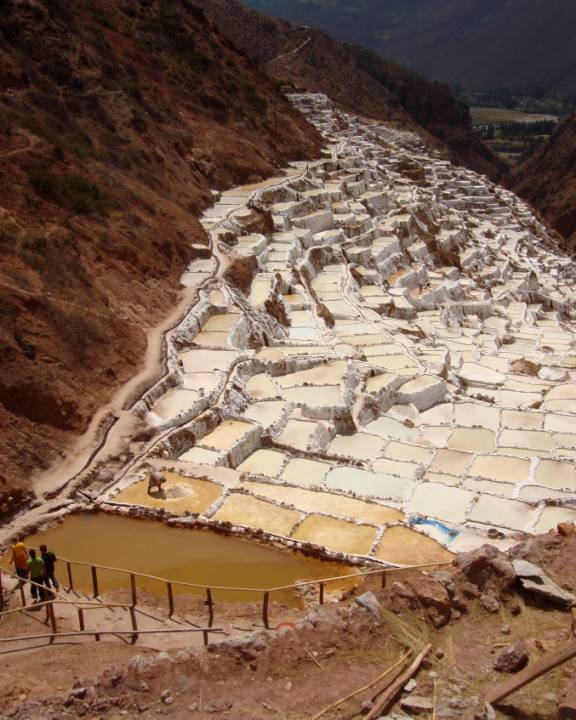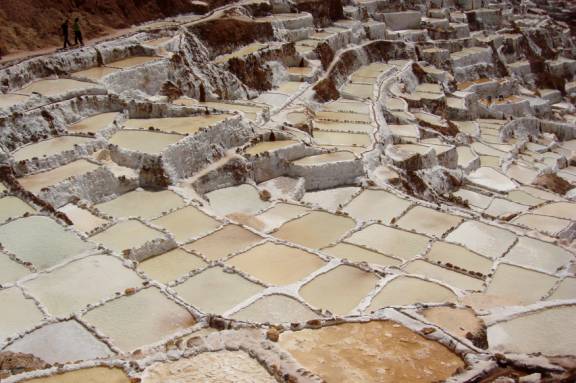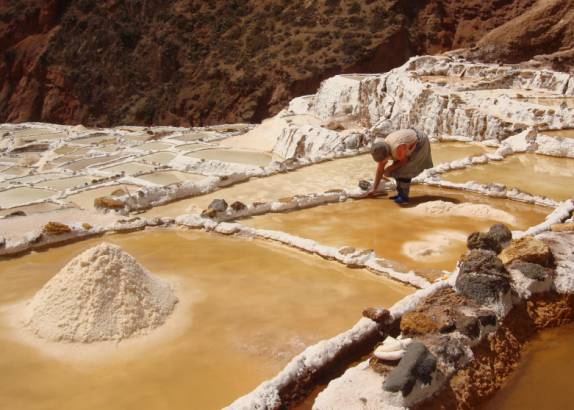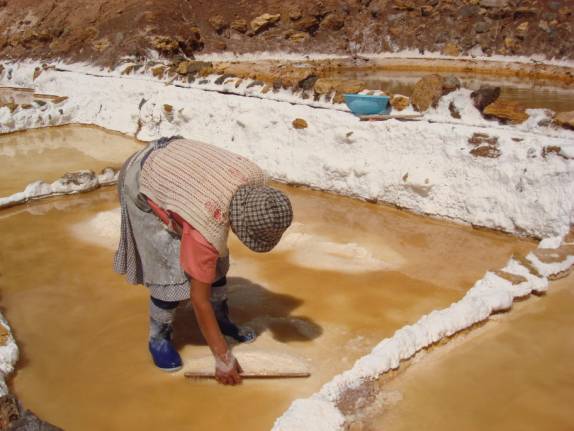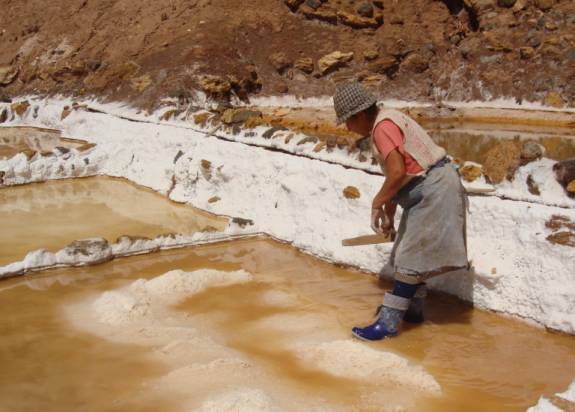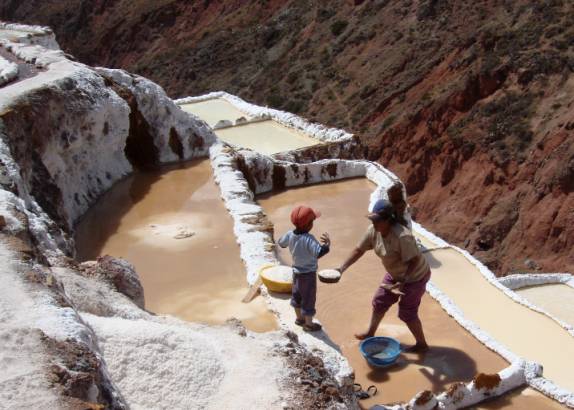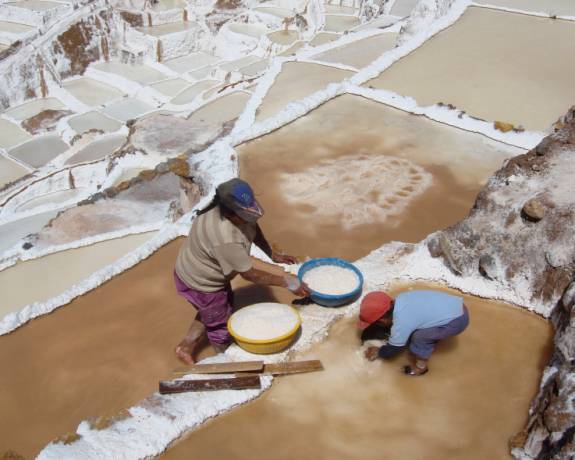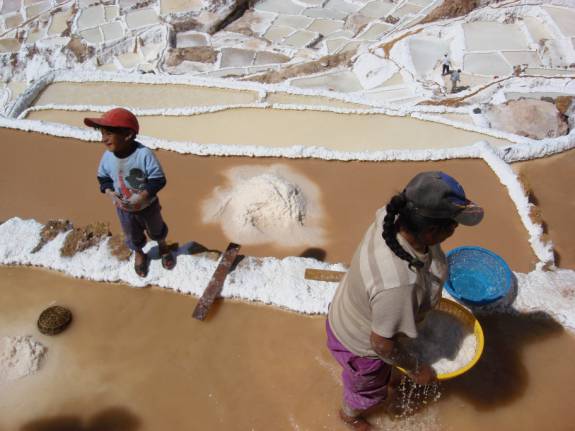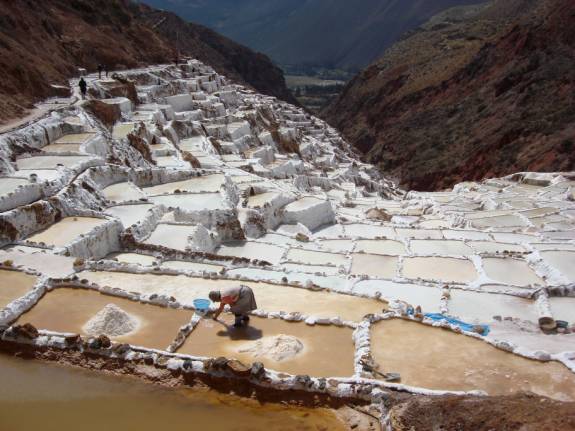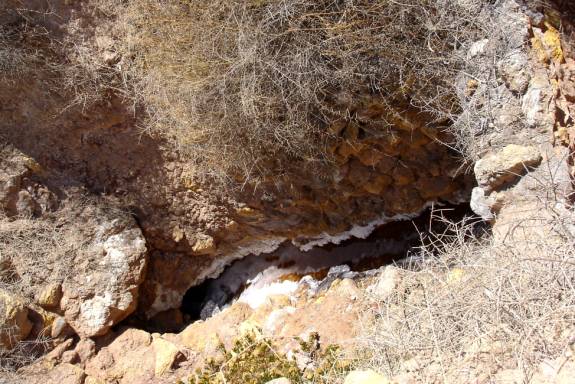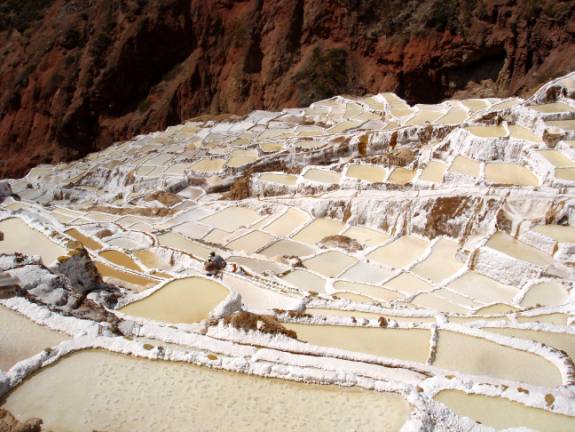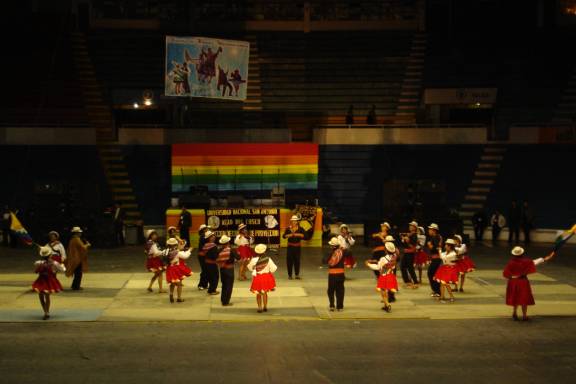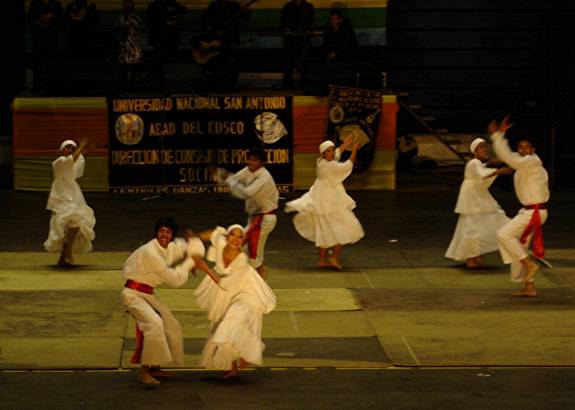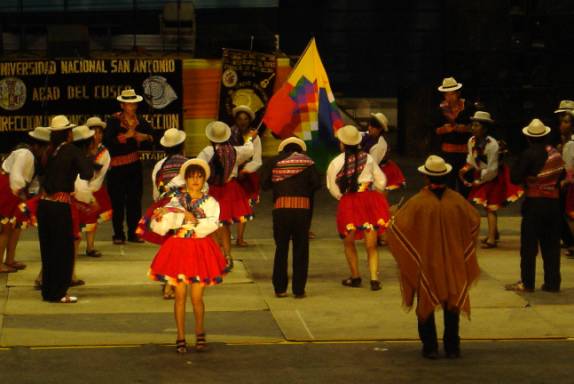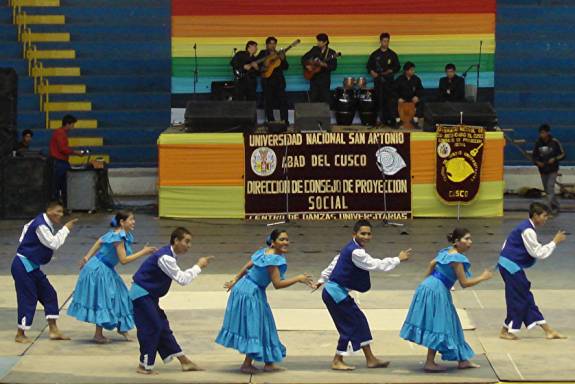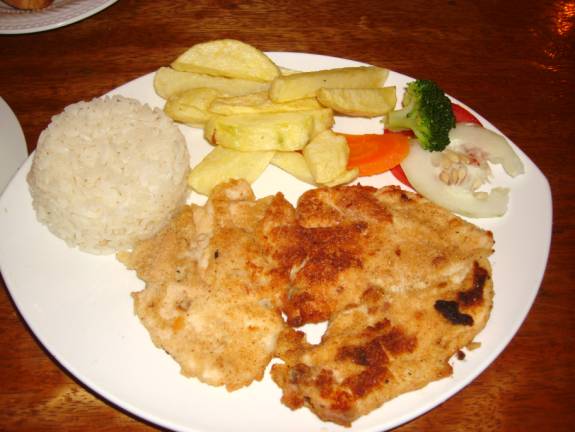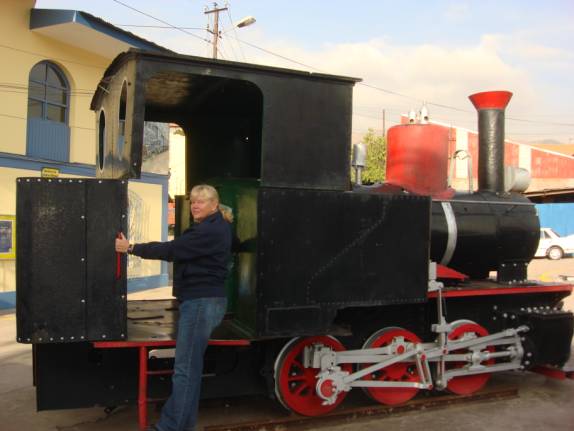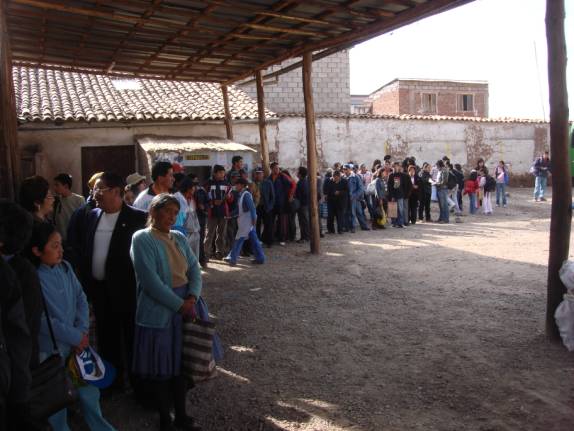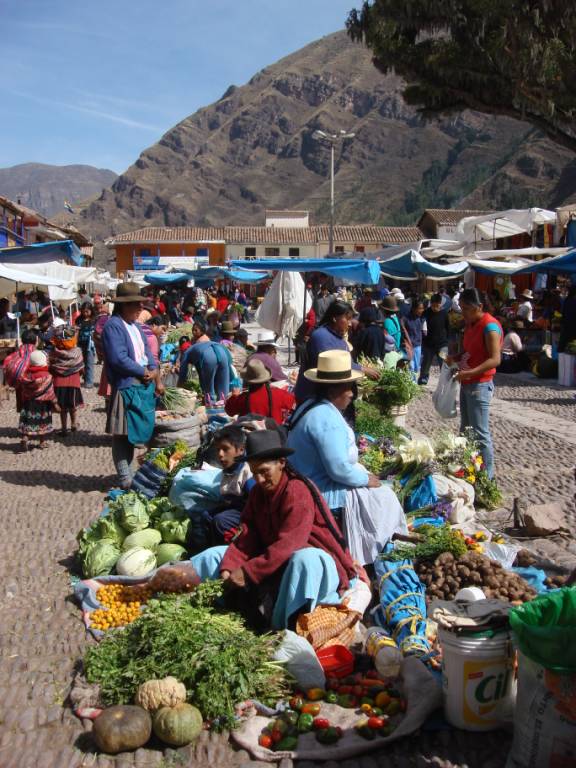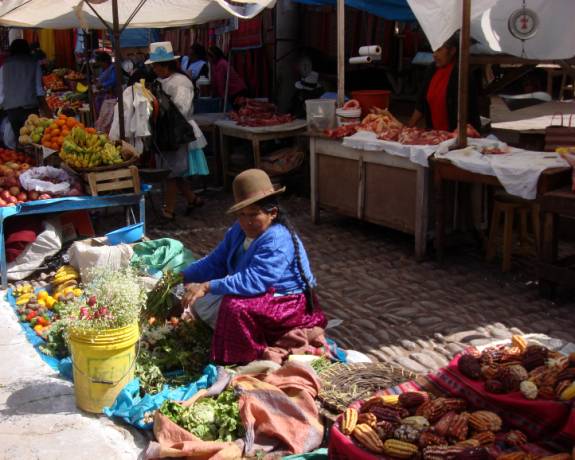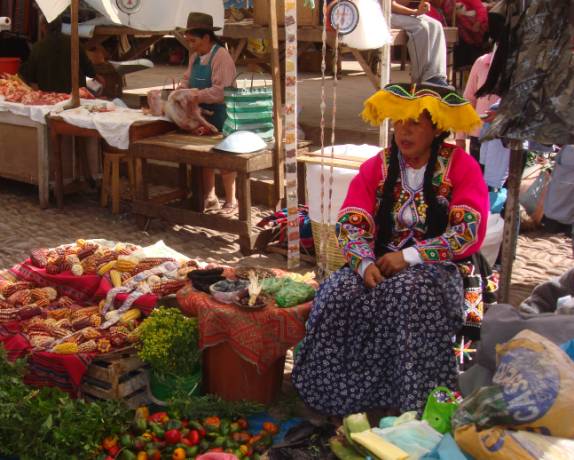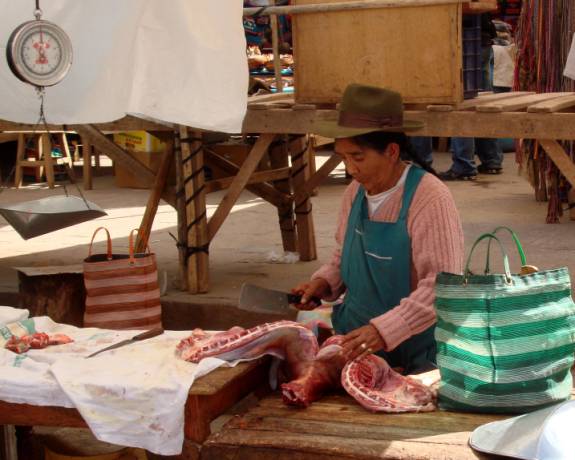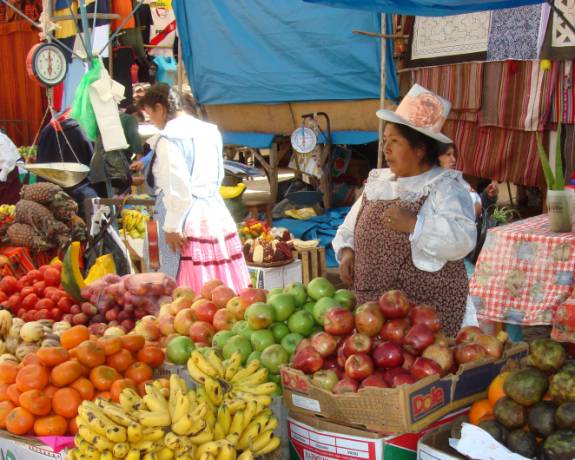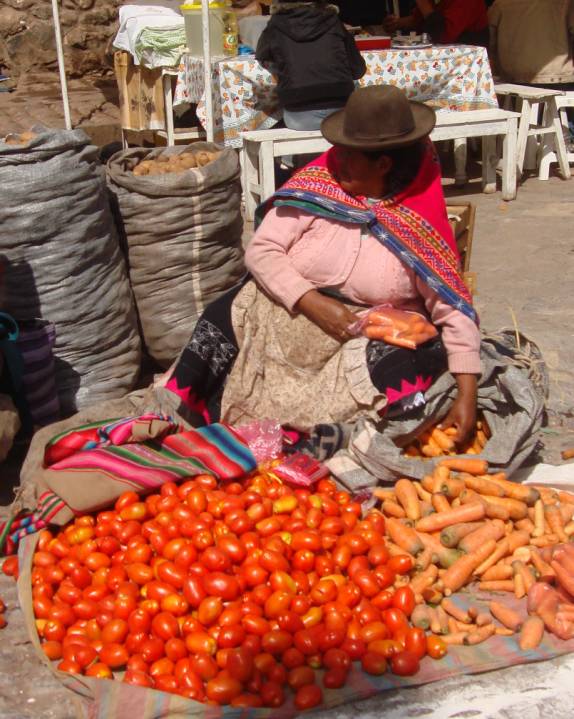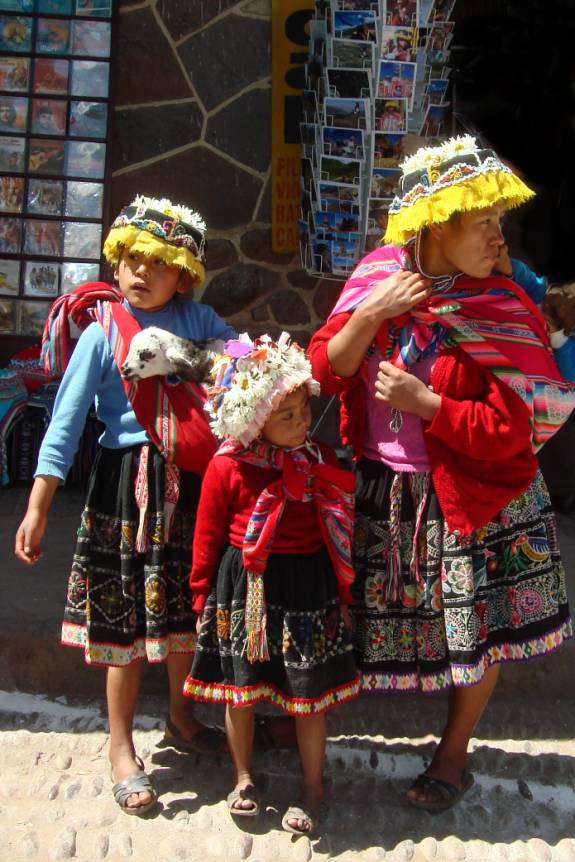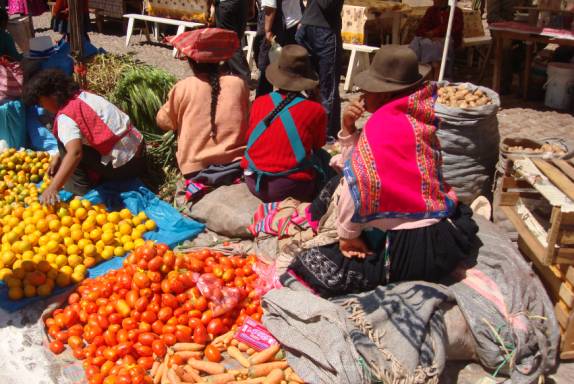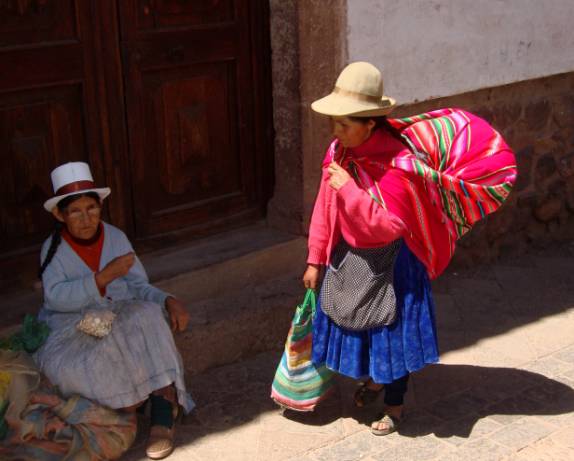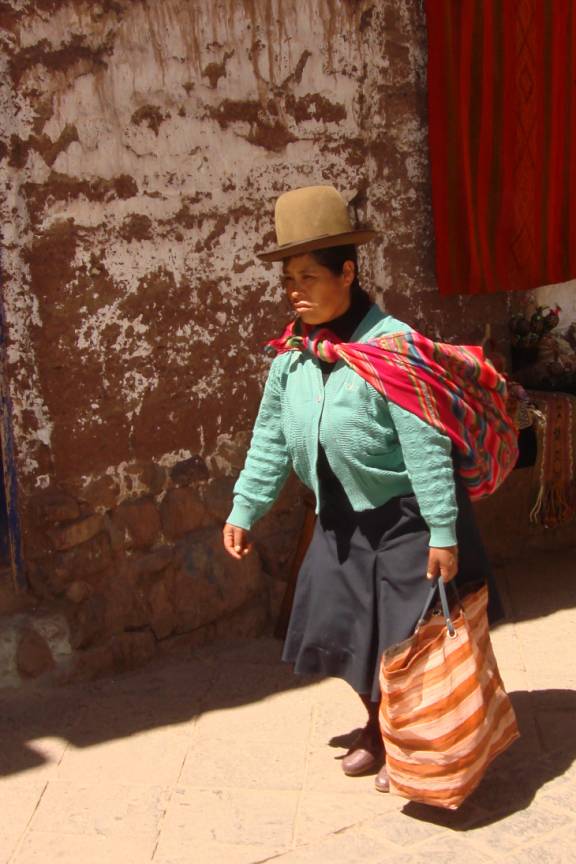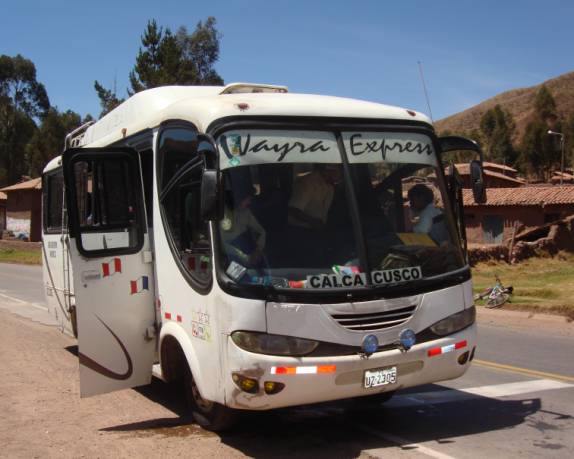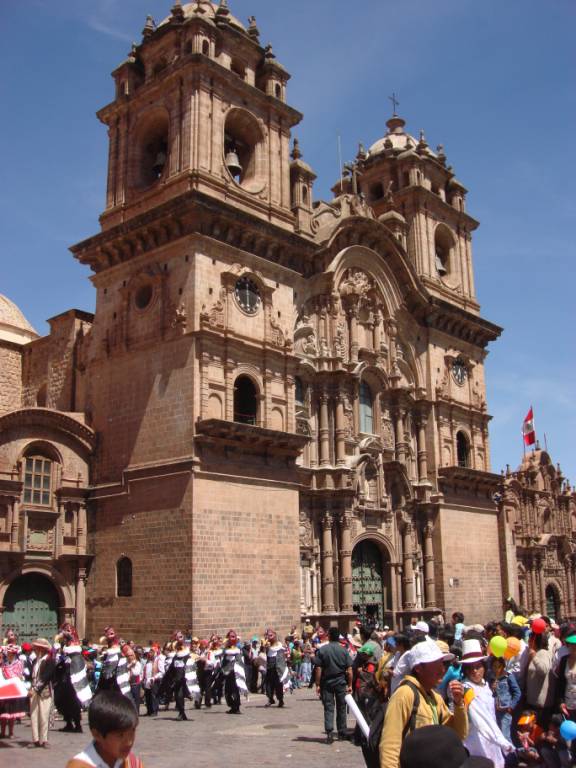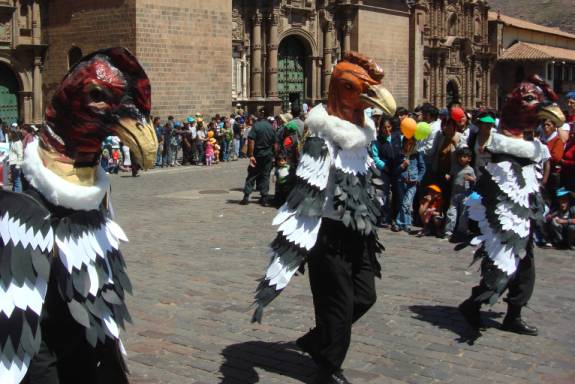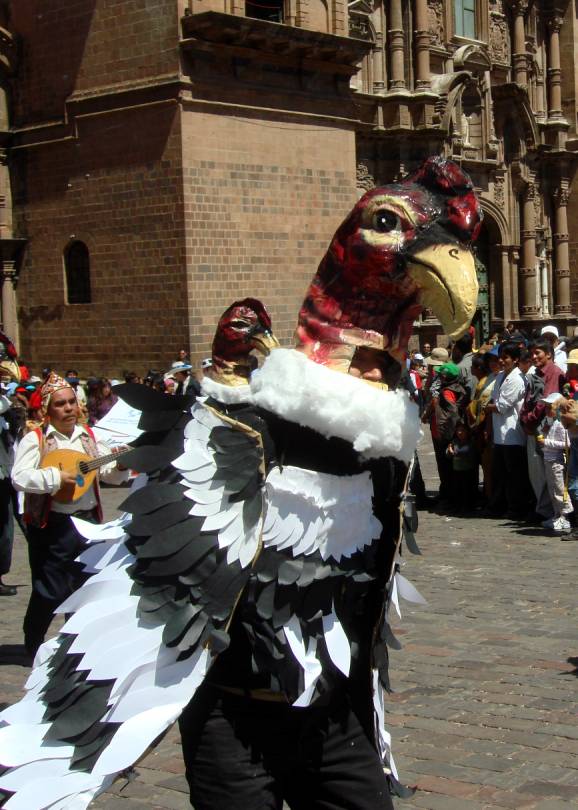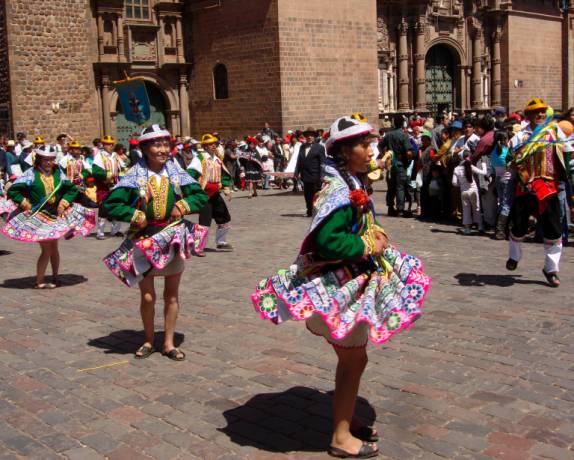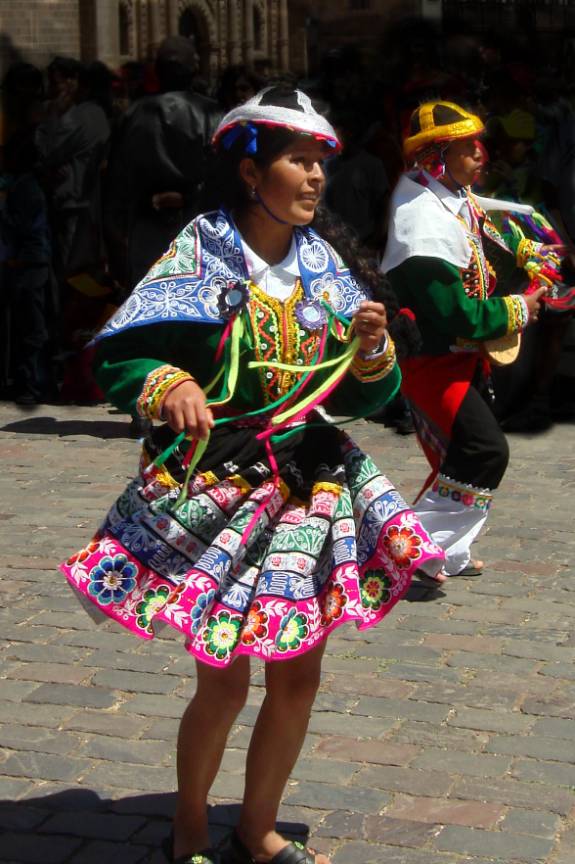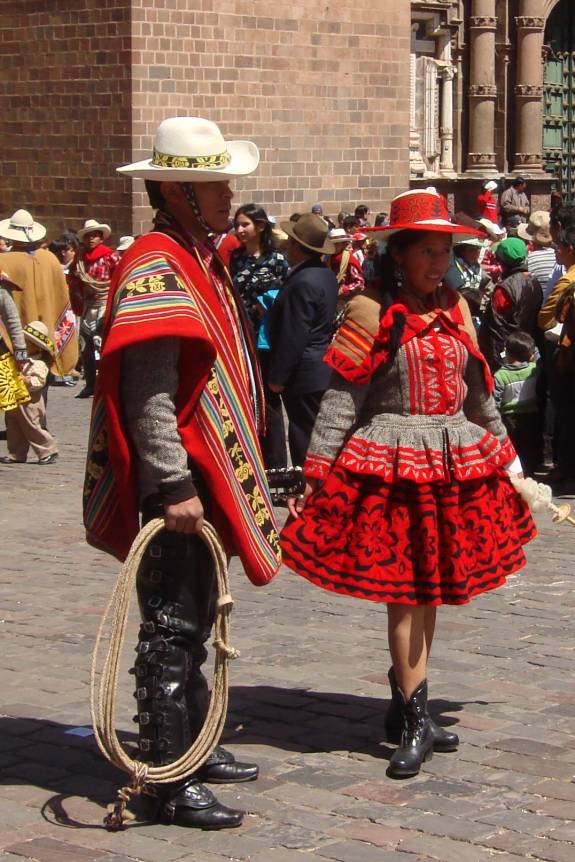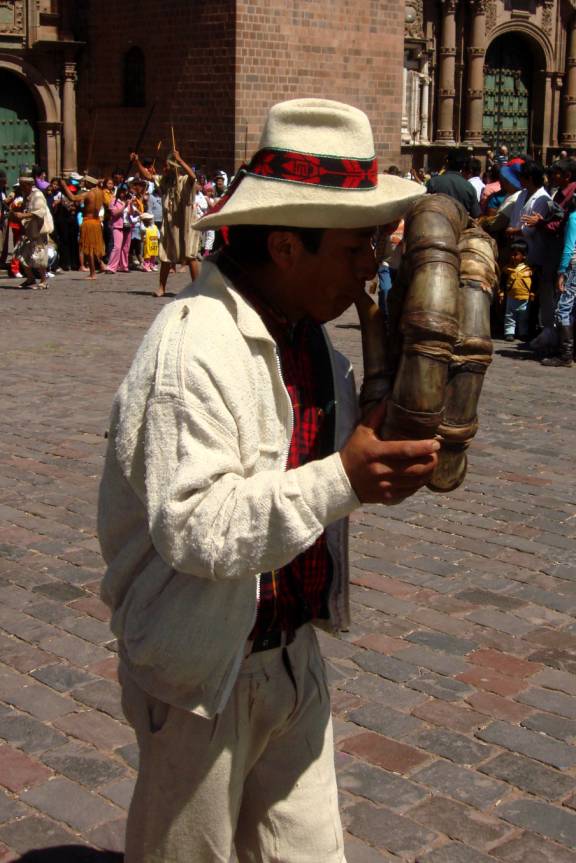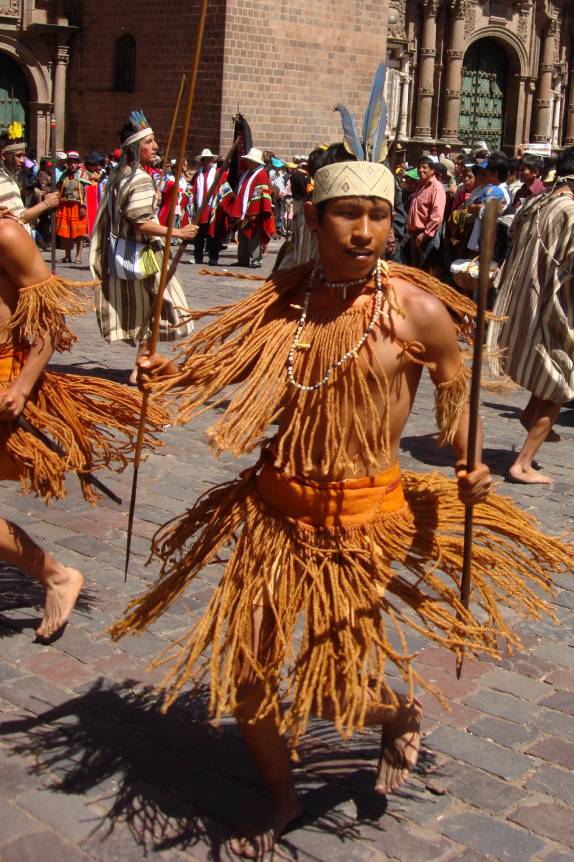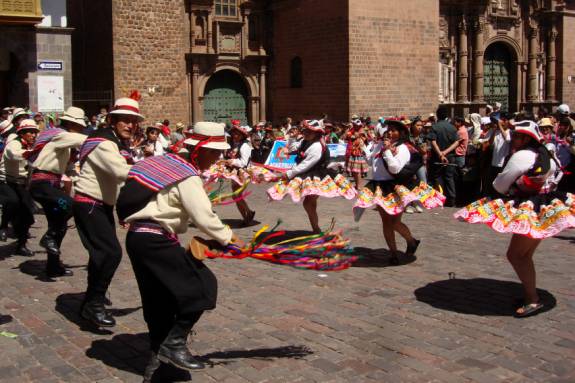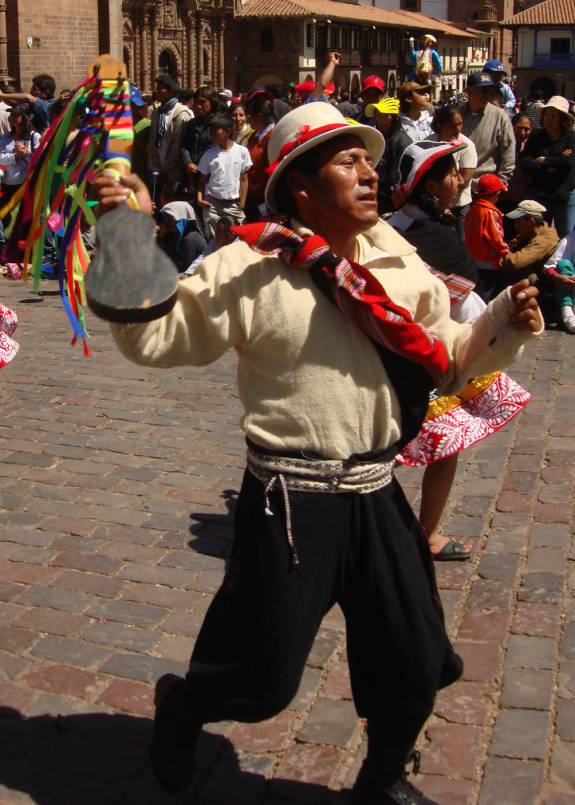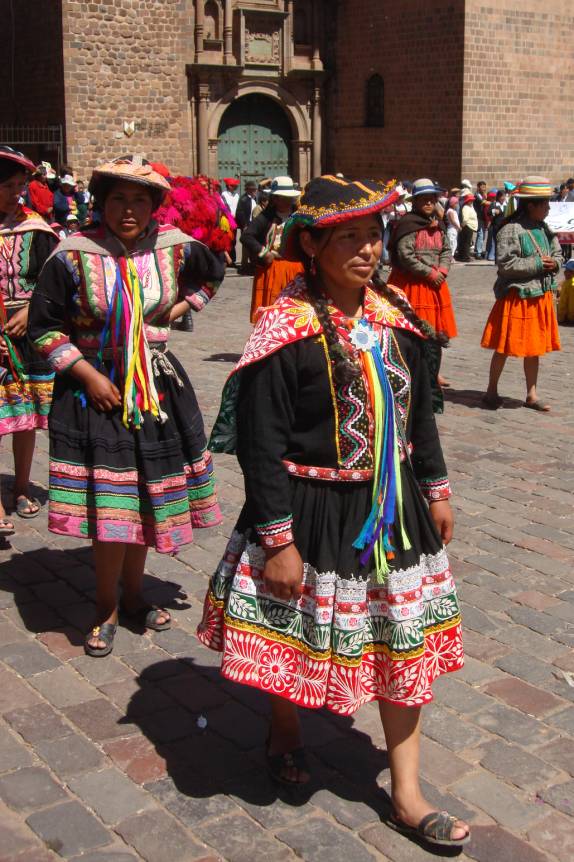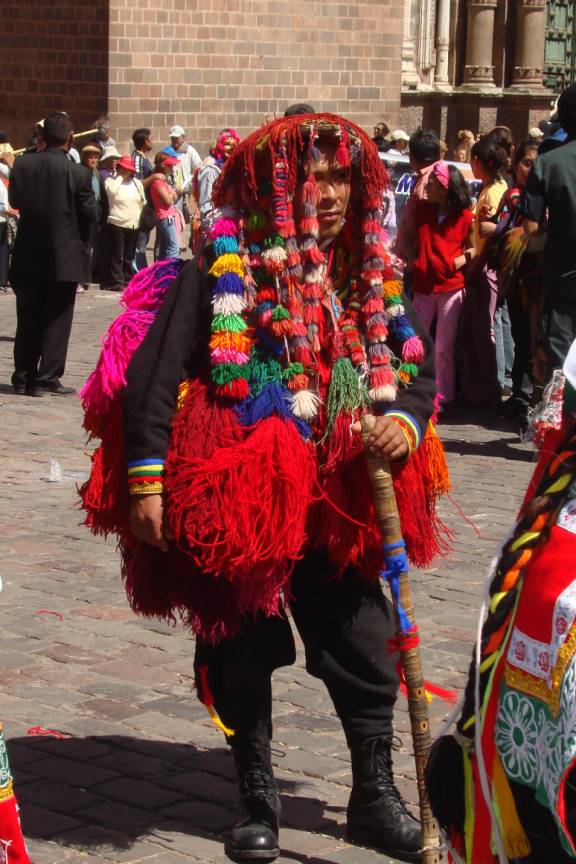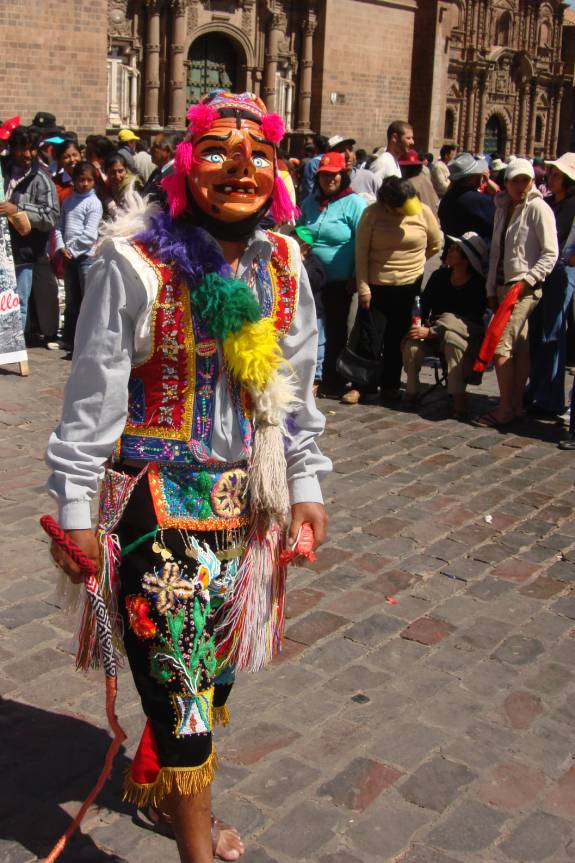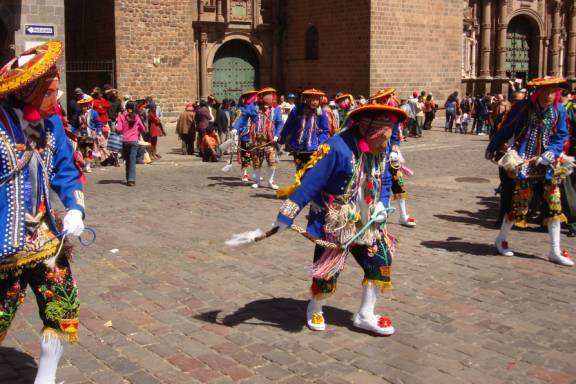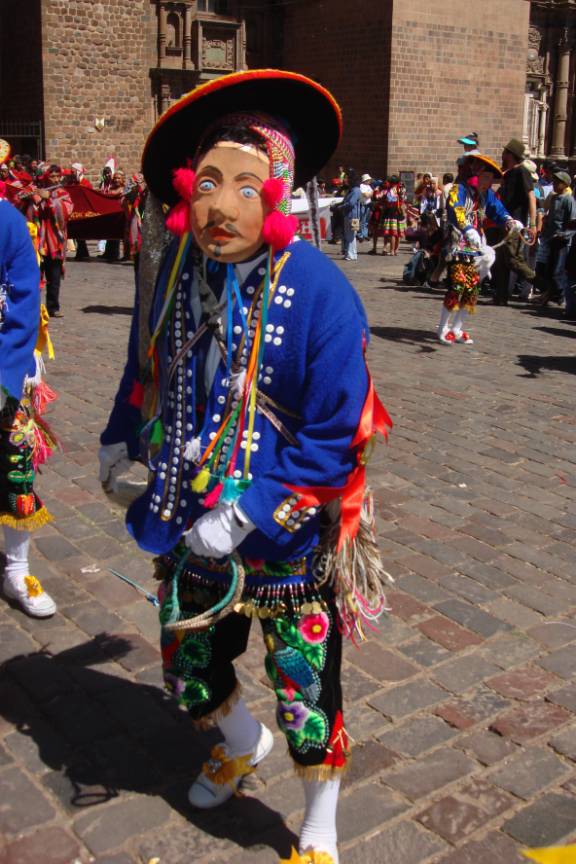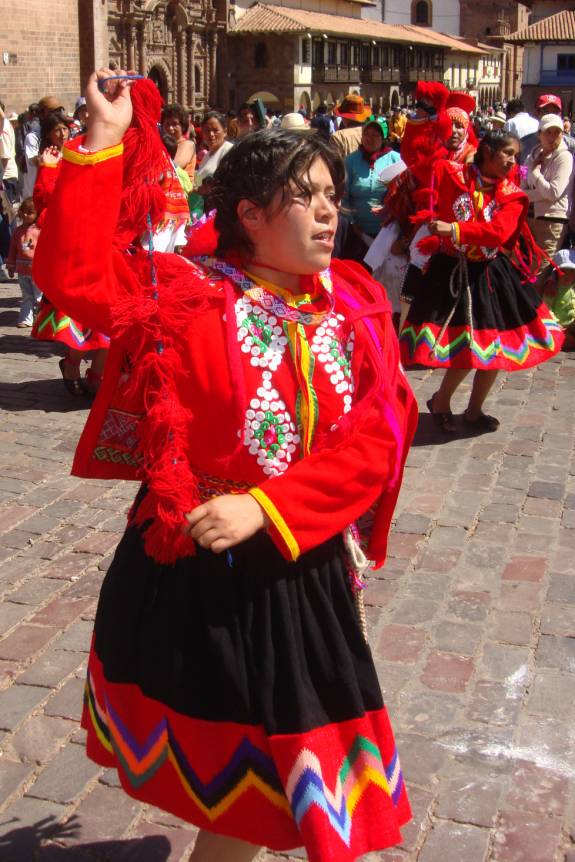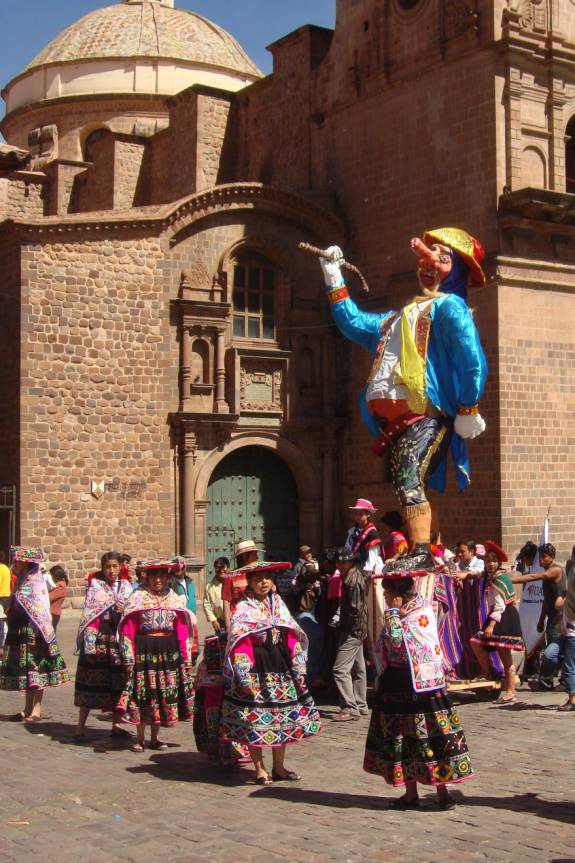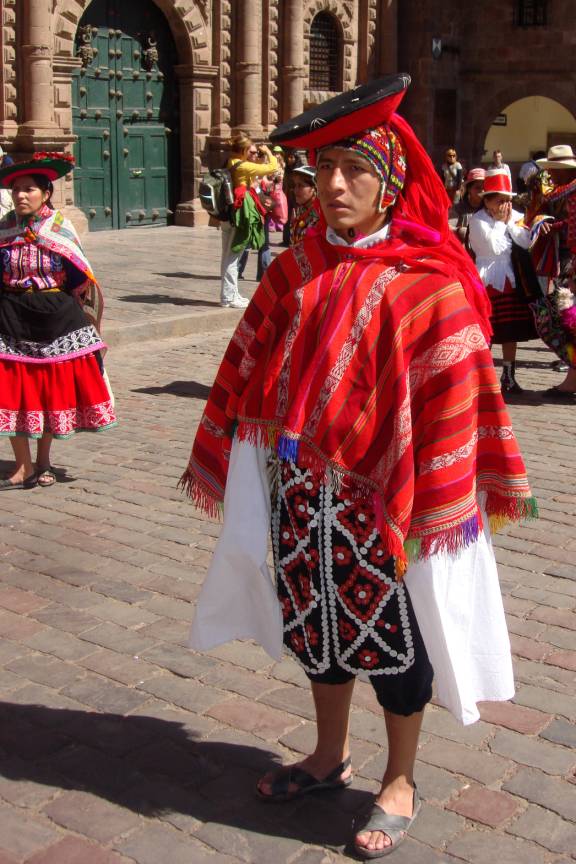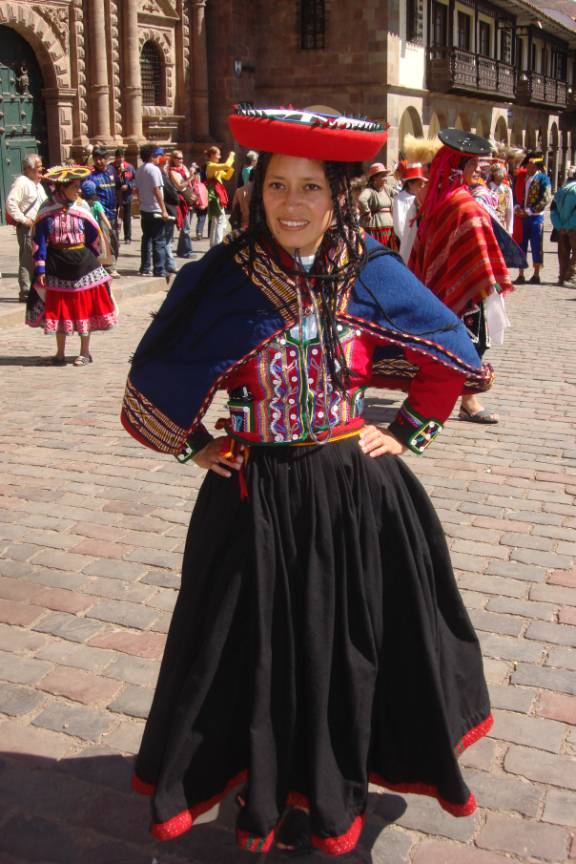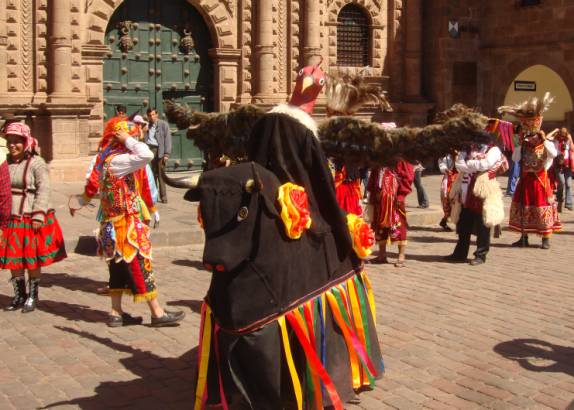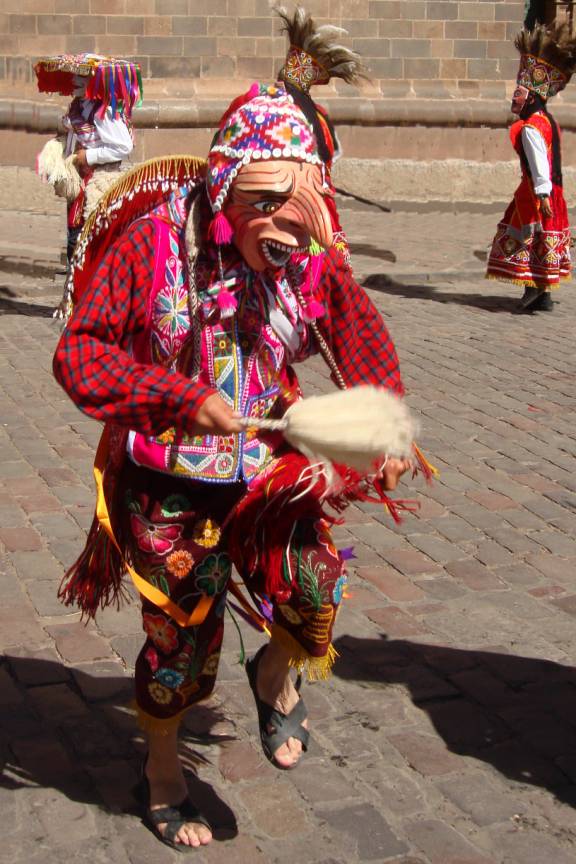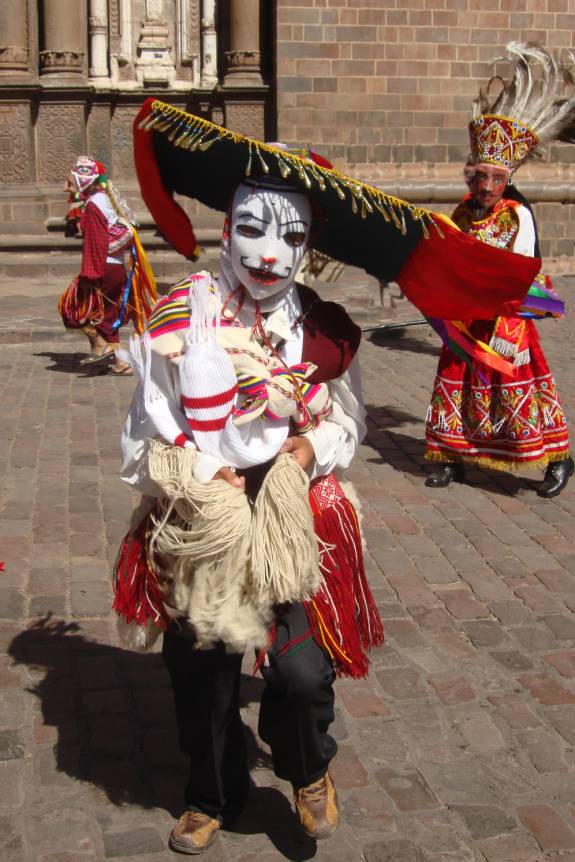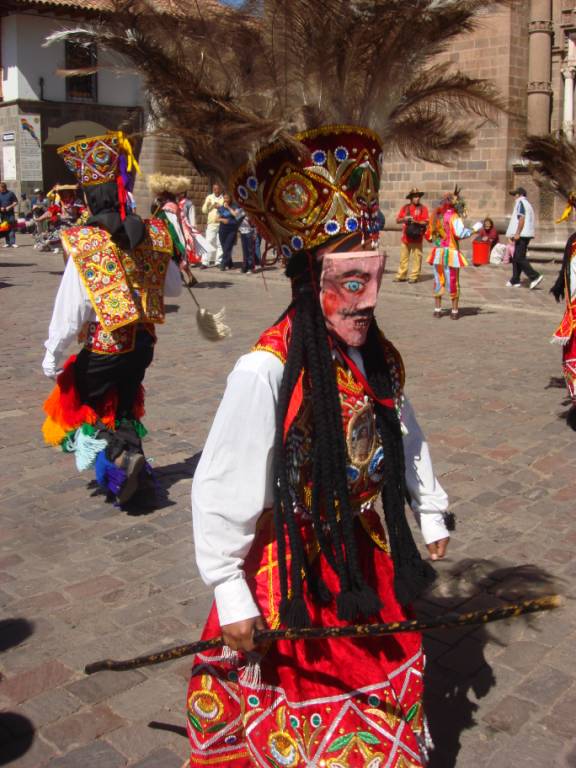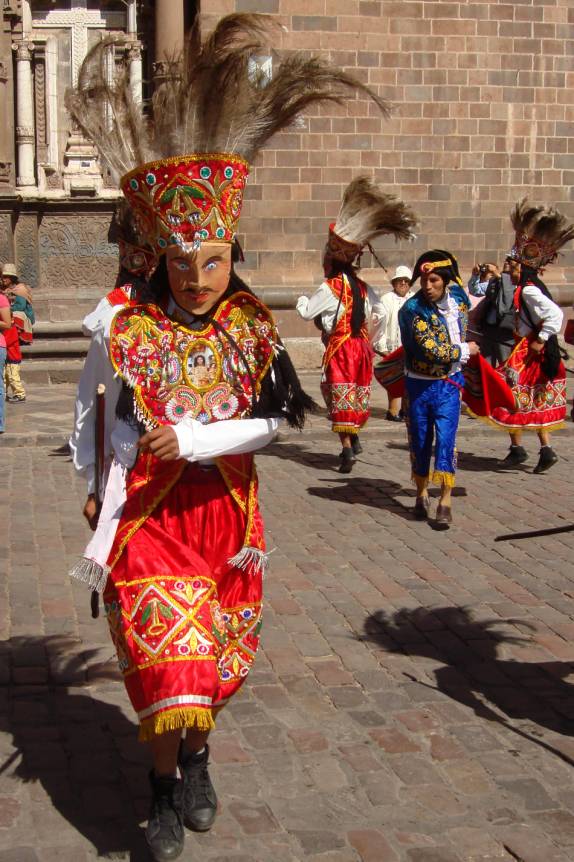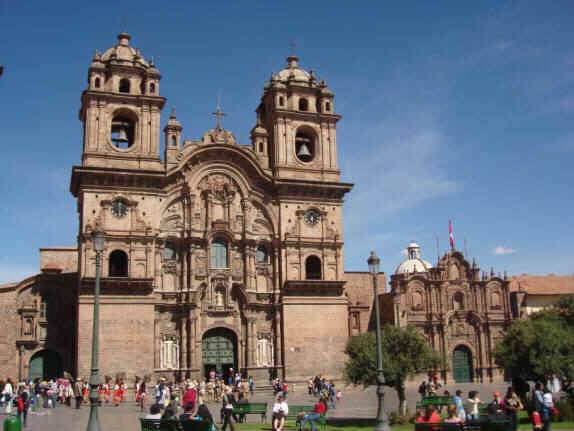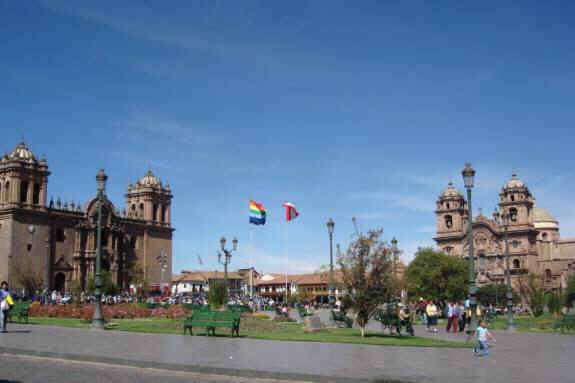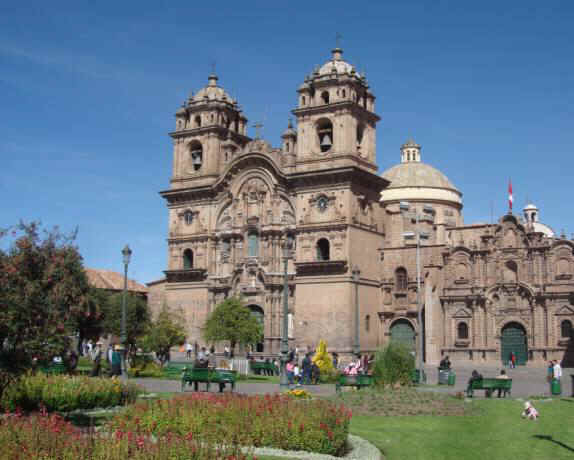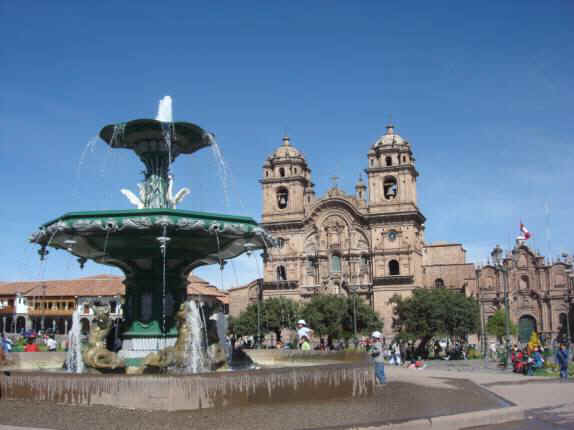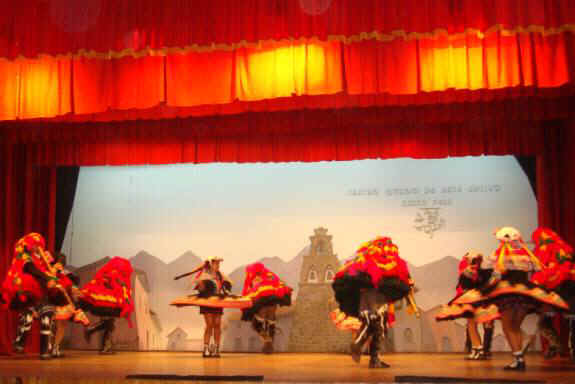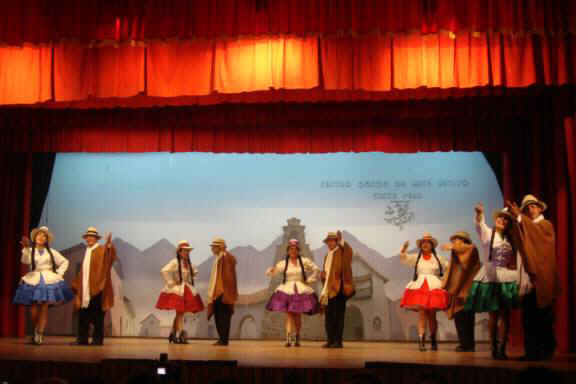|
|
|
|
Site Index:
|
UPDATE#20
08/23
thru 08/24/08
Howdy
Everybody, The
adventures of 2008 from 1/1/08 through 08/22/08 have been published on the
website. We now continue with this
latest edition. UPDATE
2008 #20 08/23/08 through
08/24/08. At
last update, we were enjoying the heart of Inca Empire, the great city of Cusco,
and the surrounding historical sites. 08/23/08
SATURDAY CUSCO –
MORAY – MARAS – SALINERAS – CUSCO
To visit the historical sites around Cusco and the Sacred Valley, you
must purchase a “Boleto Turistico” (tourist ticket).
Just recently, the price of the ticket rose sharply, doubling to 130
Soles (about $50 US). The ticket
includes about 10 different sites, however, it is doubtful that most folks have
time to visit them all.
Many of the Catholic sites are not included but do have separate entrance
fees. The fee at the main Cathedral
is about $10 US, however, if you enter during the times of morning Mass, there
is no charge. Generally, the Mass
is held in a side chapel, therefore, you are not likely to disturb anyone with
your visit.
Started in 1559, the main Cathedral took almost 100 years to complete.
It rests on the former palace site of “Viracocha Inca” and was built
using blocks pilfered from the nearby Inca site at Saqsaywaman.
To its right, the Cathedral is joined with the Iglesia del Triunfo
(1536); to its left, is the adjoining Iglesia de Jesus Maria (1733).
The main altar is a huge, silver edifice that dominates the Cathedral.
Many ornate, silver and gold side chapels with elaborate platforms and
altars adorn the Catholic Cathedral.
In a previous update, I discussed the altering of perceptions through the
use of “artist conception” paintings. The
Cathedral displays one of the most interesting examples of artistic
interpretation. Judy spotted this
anomaly almost immediately. A huge canvas, by Quechua artist Marco Zapata,
blended 17th-century European devotional painting styles with the
motifs and local customs of indigenous Andean life.
“The Last Supper” depicts one of the most solemn events of the
Christian experience but localizes the final meal centered on the Andean
ceremonial food dinner of roasted Guinea Pig.
With its little feet and head pointed toward heaven, it was a somewhat
shocking revelation about traditional history.
Many of the elegant mansions that once surrounded the Plaza de Armas have
been converted to offices and municipal buildings.
Once festive courtyards have been transformed into stark areas of
utilitarian functionality.
At about 8am, we went to the Cusi Tours office to take a tour to Moray,
Maras, and Salineras. At 9am, we
were escorted to a brand new Nissan wagon driven by our guide for the day.
The only other person for our tour was a Peruvian from Lima that spoke no
English at all. We did travel in
tandem with another private car with three additional people and their driver.
With only six travelers in two cars, it was like having a private tour,
but at a bargain group-price of $20 US dollars per person.
City life soon gives way to the rural Andean way.
Entrance fees for the agricultural complex at Moray were not included in
the Boleto Turistico requiring payment of a separate tariff.
Only
discovered in 1932, Moray is definitely unique.
The esoteric engineering concepts of the Inca culture were almost
limitless. Most commonly, civilizations have strived to build from the ground
upward. At the complex of Moray, they worked downward, removing massive amounts
of stones, rocks, and dirt. Over
many generations, thousands of manual laborers succeeded in the construction of
many groups of terraces, created in almost perfect circular forms.
A smaller set of similar, circular terraces is presently being restored
to its original grandeur. A small
Andean ceremony to honor the Inca deity, “Pacha Mama” (Mother Earth), was
being held within the lower circle.
A very sophisticated aqueduct system of irrigation canals was designed to
bring sufficient water the various levels.
Agriculturally,
Moray demonstrates a special importance. Evidently,
the Inca used it to experiment with the hybridizations of various plants and
vegetables. Scientists and archaeologists believe that the Inca would experiment
here to determine a plant’s resistance under various temperatures.
Simultaneously,
the Inca may have tried to domesticate various wild plant varieties to increase
production.
Like an enormous amphitheatre built in the form of a gigantic trough, the
series of circular platform terraces descend to a depth of 150 meters. The Incas
grew wheat, quinoa grain, coca, panti, kantu flowers, and numerous other plant
varieties as part of an agricultural development concept.
The
Moray terraces are built in such way that one can climb up and down the
concentric levels by using the steep, stair-like stones that were implanted into
the sides of the rock walls.
So perfectly engineered and constructed, the network of aqueducts and
drains for the irrigation and dispersion of rainwater still works perfectly.
The
temperature difference between the lowest level and the highest one is about 15
ºC, nearly the same difference as between sea level temperature and that at a
height of 1,000 m. Experts have
established that Moray satisfies at least 20 different climate categories
providing a suitable level of environment for the cultivation of almost every
plant species from the Inca Empire.
I was “feeling good in the neighborhood”, so I decided to make the
long climb down to the bottom depths of the deepest plateau.
The steep, stone steps made the climb out significantly more strenuous
than the descent. At these high
altitudes, the effects of moderate exertion are much more noticeable than at sea
level.
Continuing along the Alto Plano (high plain), we sped along the dusty
roads to our next interesting site.
From high atop this mountain road, we looked down at the amazing salt
pools of Salineras.
A steep path gave access to the surface levels of these thousands of
pools. Founded in Inca times, these
mines were the largest salt producers in
the highlands region during the Spanish regime.
The ancient “Las Salineras de Maras” (Inca Salt Pans) dot the
precipitous hillside and cliffs with white salt.
The harvesting of the salt is done completely by hand.
The pools are filled with salt-rich water
from the spring located above the pools. Workers
perform the backbreaking task of scraping the evaporated salt crystals into
large piles.
Most of the salt produced here now is a grade used for animals feed,
however, some of the finer pools produce a table grade crystal.
The individual pools are flooded with the spring water and sealed off.
Approximately every 3 days, additional spring water is allowed to refill
the pools. Of course, no
sophisticated valves or controls are used.
The local workers simply place or remove rocks to channel the water into
the pools from the single source salt stream.
Following numerous stages of refilling and evaporation, sufficient
crystallization process has occurred and the salt can be skimmed out.
Just imagine, “this cute blond, some of that salt, a lime, and some
Tequila”. Ya-hoo!
Individual families separately own the pools.
At one time many years ago, about 50 families owned all of the pools.
Ownership rights to the salt pools are handed down within families like
heirlooms. As the “family
trees” branched wider, the numbers of different families with salt plots has
reached the point where few families have more that 5 or 10 pools under their
individual control. The owners can
sell or barter their salt for individual profits.
From somewhere deep in the earth, this hot spring comes heavily laden
with the rich salt solution. We
were told that the salt content of the water never varies.
How’s this for a really “salty sailor”?
The Nissan wagon started out spotlessly clean this morning.
Someone will be washing it again tonight.
This beautiful building is the Palacio de Justicia (courthouse) in Cusco.
While peaking into a university building near the main plaza, I noticed a
bulletin board with mention in Spanish about a performance of folkloric dances
to be held this evening. I asked
the security guard and got information about the location.
I don’t think he really knew much about it because he gave us the wrong
directions. Now, I know it’s not
very manly to ask directions, however, in Peru, you better ask lots of questions
to lots of people if you hope to find someplace.
After receiving bad directions twice, I asked again and a very nice and
helpful hotel clerk pointed us in the right direction, which was a couple of
miles away. The others had given us
directions to “El Colosio” whereas what we needed was called “El Colosio
Cerrado”. With the correct name,
we were able to get there by taxi quite easily.
We arrived at the coliseum early in hopes of finding good seats.
We picked the best with an excellent view of the stage.
Apparently, we must have seated ourselves in the reserved seats for the
dignitaries. Much to our surprise,
the staff politely asked everyone else in this section to move to other areas.
For some unknown reason, no one ever said a word to us and always offered
delightful smiles cast in our direction. Of
course, Judy was the only blond and I was the only white-haired person in the
arena. They must have assumed that
we were important dignitaries from a visiting university or something.
When the special patrons and dignitaries began to arrive, we were greeted
with warm cordiality. We were even
offered drinks and snacks by the groups. Who
of you can understand this kind of good fortune?
Once again, Judy must be our good luck charmer.
Hosted by the University del San Antonio Abad, the performers had
gathered from all over South America to display their skill and interpretation
of historic folk dances. The
University has a special program that studies and concentrates on various forms
of dance that tell the historical stories of rural Andean life in times long
past.
Some of the groups used recorded sound music; others performed to their
own live band groups.
The music and dance expressions were very enjoyable.
Unfortunately, much of the storyline basis is beyond our level of
comprehension.
The dancers were very accomplished and the costumes were bright and
colorful.
The evening turned out to be a wonderful cultural experience that we felt
privileged to have observed and enjoyed.
At night in Cusco, you will definitely be glad you brought that warm
jacket. Although these winter days
have been much warmer than we expected, these high altitude nights can chill you
to the bone in short order.
Having enjoyed the Haylliy Café before, Judy found interest for the
complete dinner featuring “Milanesa de Pollo” (breaded chicken breast).
We add our recommendation for this good, economical eatery.
We have taken so many pictures on this trip that we have already filled
our camera storage chips to capacity. Fortunately,
we found a place that could transfer our data to DVD disc storage and release
our chips for more photo opportunities.
Another task for the evening was to locate our choice of transportation
for our trip to Puno this next week. I
recommend that you shop around at various agencies.
We were quoted between $35 and $50 US for the same exact trip on the same
bus. Can you guess which one we
chose? 08/24/08
SUNDAY CUSCO – PISAC
– CUSCO
Although we had made reservation and completed the payment using the
internet, we had to physically pick up our tickets at the main train station
called, “Estacion Wanchag”. The
ticket area was quite crowded with folks awaiting their number to be called.
Once again, Judy’s luck prevailed when a nice guard escorted us to a
ticket booth back in the adjacent area. In
less than 15 minutes, we were done and gone with tickets for Tuesday in hand.
Too cool…!
Our plan for this Sunday morning had us taking a bus to the village of
Pisac. The market there is very
well known for its native presence and local customs.
Based on the recommendation from our hostal clerk, we went to the
“Caminos Los Inkas” bus station located on Calle Puputi.
The line was quite long, however, leaving every 15 minutes, we were able
to get seats on the 3rd bus out.
When the bus leaves the station, only people with seats depart.
Within minutes, every square inch of the bus was jam-packed full after
the first few stops.
On the way of the hour long trip, one young kid happened to get sick.
It was interesting to watch the people offering him comfort and
assistance. No one seemed at all
upset. One of the remedies was to
have him sniffing on cotton soaked with rubbing alcohol.
Once again, we were the only non-locals on the bus.
When we got to the famous market at Pisac, there were lots of tour buses
around. Most appeared to be
European tourists eager to acquire souvenirs during their highly organized
vacations. Of course, there were
lots of cigarette smokers.
On another note, the market was delightful.
The native market and Andean customs are very interesting and
significantly different.
It is very obvious that the native women run the markets.
My camera was “clicking” faster than a cricket-in-heat.
This flautist appears to have created his musical instrument from a
simple piece of PVC tubing. I’m
reminded that, “Music comes from the musician, not from the instrument.”
In an attempt to beat the rush back to Cusco, we hopped aboard the Wayra
Express bus, which was the next to leave. As
you can probably guess, the bus was mobbed with parcel-loaded shoppers.
The bus was overheating because of a leaky cooling system.
It was almost humorous to watch the driver and his helper scurrying to
the stream alongside the road with jugs to fill the radiator.
Unfortunately, most of the water seemed to be leaking out almost as fast
as they could pour it in. Soon, we
were back on our way.
One of the local communities was engaged in a parade and ceremony
proceeding down the middle of the main roadway.
Judy managed to snap some great photos through the front window of the
bus.
Without much delay, we continued to the city of Cusco.
We hailed a taxi to take us to the main Plaza de Armas.
The streets were barricaded and we had to get out of the taxi before the
Plaza. Much to our surprise and
delight, a huge celebratory procession was just getting started.
Turned out that the event was an annual exposition of folkloric dancers
that have gathered here in Cusco to demonstrate their finest moves to honor
their heritage and history. Wow,
are we lucky or what? We had no
idea that this was happening. We
found a great observation point near the front of the “Iglesia De La Compania
De Jesus”.
You may remember that the “Condor” was the revered link between the
“Land” and the “Sky” in the Inca belief.
Dancers, male and female, whirled and twirled to the music and
traditional customs of their ancestors.
The brilliant colors and exuberant performers were captivating.
The variety of styles typifying their homeland regions provided an
endless array of photographic opportunities.
This historic musical instrument was created with animal horn and leather
bindings.
This energetic group portrayed dance traditions of angry jungle warriors
from the distant Amazon region of the Inca Empire.
A big problem for these high-steppers was the extremely hot stone blocks
of the street. In their bare feet,
the dancers were not prepared to encounter the burning pavement.
Enthusiastic dancing was only one of the reasons for fast moving feet.
To help them, some spectators threw pieces of paper down for the dancers
to stand on while resting. It must
have been terribly uncomfortable.
This colorful character represents a highly decorated “llama”.
The llama was the honored beast of burden in these highland regions.
The procession was a feast of color and sound.
Many hundreds of Peruvian participants moved in synchronized harmony to
delight each of the senses.
The expressions and enthusiasm continuously thrilled us from every view.
It was evident everywhere, the personal pride in their native origins and
vibrant heritage.
She exudes amazing, youthful beauty, fabulously adorned with the colorful
garb of her ancestors.
Do you remember the Andean ritual that pits the inebriated “Condor”
against the violently angry “Bull”?
This character represents the “Alpaca” animal in the folkloric dance.
We enjoyed many hours of the fabulous celebration.
With the dances and processions completed, the “Plaza de Armas” and
the “Iglesia La Compania” returned to their awesome prominence.
From across the Plaza, the Cathedral is to the left in the picture and
the Iglesia La Compania sits to the right in the photograph.
The rainbow flag represents this city of Cusco, while the Red and White
banner is the national flag of Peru.
Built in 1571 by the Jesuit order, the foundation of the “Iglesia La
Compania de Jesus” was constructed upon the palace of Huayna Capac, the last
Inca leader to rule over an undivided, sovereign empire.
Designed to be the most beautiful church in the entire city, it created a
huge disagreement with the Archbishop of the Cusco who felt that the design
conflicted with the power and honor of the main Cathedral.
The Archbishop sought assistance and consultation from Church leaders in
Spain, and even from Pope Paul III for intervention, however, their official
concurrence came too late to change the nearly completed edifice.
Following the destructive earthquake of 1650, the church underwent
extensive reconstruction.
In the right side of the main Cathedral, the adjoining building is the
oldest Catholic Church in Cusco. Iglesia
del Triunfo was built in 1536 following the conquest of the former Inca capital.
The amazing Inca wall of Qorikancha is a little of what was once the
richest temple of the Inca empire. With
the demise of Inca power, as a result of the Spanish Conquest, the catholic
Dominicans constructed a church atop the remnants.
Historians
tell us that the former temple was covered with gold. It is said that some 700
solid-gold sheets lined the massive walls.
Life-sized gold and silver artifacts of corn were ritualistically 'sowed'
in agricultural ceremonies. Silver lined inner-temples and solid-gold religious
art treasures, including sacred altars, llamas, and baby children, adorned the
Temple dedicated to their highest deity, the Sun God.
Shortly after the arrival of the Spanish conquistadors, the entire
accumulation of this incredible wealth and art had all been looted and melted
down. The incredibly valued
“spoils” were sent home to Spain for use by the King in financing his war
effort.
The “Iglesia Y Convento de Santo Domingo” was constructed over the
Qorikancha Temple site.
When we returned to our room to clean up for the evening, I could not
resist the temptation to snap another picture of the view from our room area.
Notice the inscription on the mountain face proclaiming, “Viva El Peru
Glorioso” (long live glorious Peru). I
would certainly agree!
Our “Boleto Turistico” (tourist ticket) included a performance by the
“Centro Qosqo De Arte Nativo” (Center of Native Artes in Cusco).
The dance presentation only lasted about an hour; however, they covered a
range of folkloric dances from numerous regions of the country.
Still able to muster a little more energy, we, once again, tried our hand
at the “Tragamonedas” (casino slot machines).
Of course it was fun, however, the house remained in control of the odds.
Summoning a little Daewoo taxi, we returned to the Hostal Coriwasi on
Calle Suecia, # 561. Nearly
exhausted, we rested well knowing that we had fully enjoyed another fabulous day
of awesome sights and adventure. TO
BE CONTINUED…SOON… Thanks
for allowing us to share our life and adventures with you. Lotsa
Luv, Fred
Reed and Judy Law AMARSE MT40 Our website is: www.amarse.net .
|
|
Fred H. Reed |
www.amarse.net © 2006 2007 2008 2009 2010 2011 |

